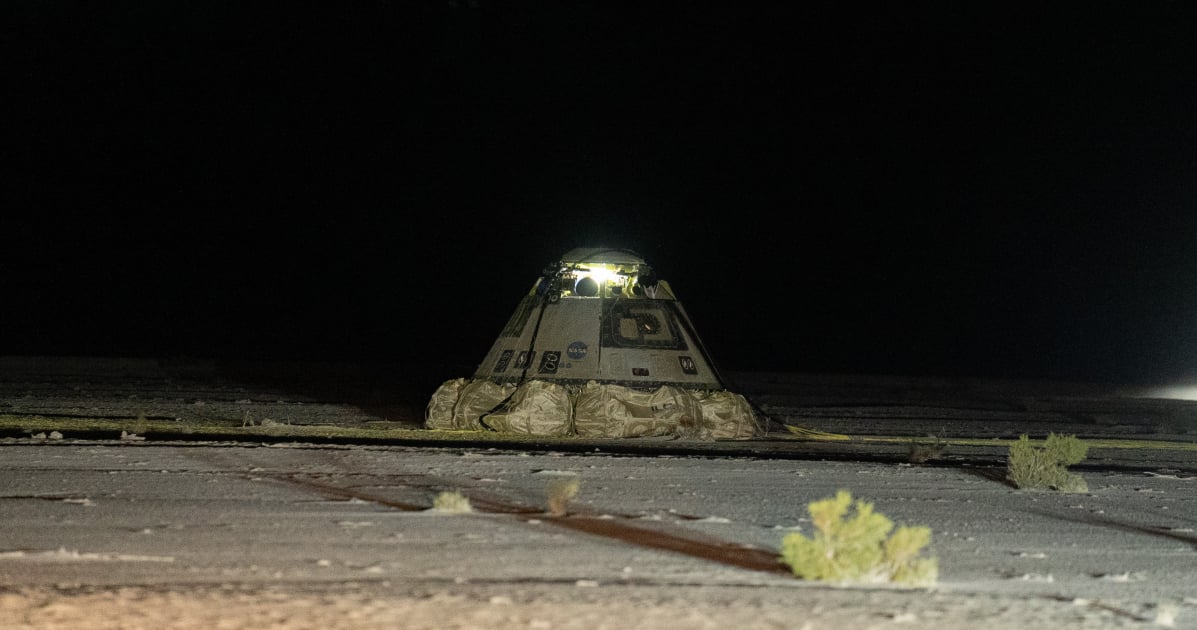
Boeing’s star-crossed Starliner capsule safely undocked from the International Space Station and landed in White Sands Space Harbor, New Mexico, without its original crew on board.The CST-100 capsule’s deorbit, reentry, and touchdown under parachutes happened apparently free of earlier glitches with the spacecraft’s thrusters that led NASA to keep astronauts Butch Wilmore and Suni Williams on the ISS until February, when they will return on a SpaceX Crew Dragon capsule.“Teams here on the ground reporting a good burn,” NASA commentator Brandi Dean reported after the spacecraft finished firing its larger thrusters at 11:18 p.m. Eastern Friday to slow its velocity and send itself back through Earth’s atmosphere. Starliner landed on the desert floor under three parachutes, cushioned by nitrogen-filled airbags extended below the conical vehicle, at 12:01 a.m. Saturday. “A safe and successful landing was exactly what we wanted,” said Joel Montalbano, deputy associate administrator for NASA’s Space Operations Mission Directorate, in a post-landing press conference. “All those thrusters did really well,” said Steve Stich, manager of NASA’s commercial crew program, noting that two exhibited higher-than-planned temperatures. That was one of the issues that NASA and Boeing spent months assessing before deciding to keep Williams and Wilmore on the ISS and return them on a Dragon to be launched Sept. 24.“Boeing’s already formed teams to look at the changes that need to be made,” Stich said. The next flight of Starliner is now scheduled for the second half of 2025, but completing those changes will take priority: “Fix those things, and then go fly when we’re ready.” Boeing did not participate in the press conference.Things had looked brighter for Starliner after a June 5 launch following years of delays in Boeing’s effort to build and fly the capsule under a $4.2 billion fixed-price crew-transport contract NASA awarded in 2014. Boeing, once a favorite to be the sole recipient of that award, then stumbled through a series of mishaps during development and earlier test missions that have so far led it to record more than $1.5 billion in losses.
Recommended by Our Editors
The $2.6 billion NASA granted to SpaceX at the same time, meanwhile, proved to be money vastly better spent. Dragon first flew with astronauts in May 2020 and has since become a reliable ride both for ISS astronauts and private projects such as the upcoming “Polaris Dawn” mission, planned to feature the first private spacewalk and the highest altitude reached by humans since the final Apollo mission to the Moon. Asked during the press conference about this mixed record, NASA officials said they’re confident with the results so far, not just for the agency, but for the nascent private space-transportation industry. “When we started, it was kind of an experiment,” Stich said. “But now we’re starting to see the benefits of the investments by both NASA and our partners.”
Get Our Best Stories!
Sign up for What’s New Now to get our top stories delivered to your inbox every morning.
This newsletter may contain advertising, deals, or affiliate links. Subscribing to a newsletter indicates your consent to our Terms of Use and Privacy Policy. You may unsubscribe from the newsletters at any time.
About Rob Pegoraro
Contributor
Rob Pegoraro writes about interesting problems and possibilities in computers, gadgets, apps, services, telecom, and other things that beep or blink. He’s covered such developments as the evolution of the cell phone from 1G to 5G, the fall and rise of Apple, Google’s growth from obscure Yahoo rival to verb status, and the transformation of social media from CompuServe forums to Facebook’s billions of users. Pegoraro has met most of the founders of the internet and once received a single-word email reply from Steve Jobs.
Read Rob’s full bio
Read the latest from Rob Pegoraro






